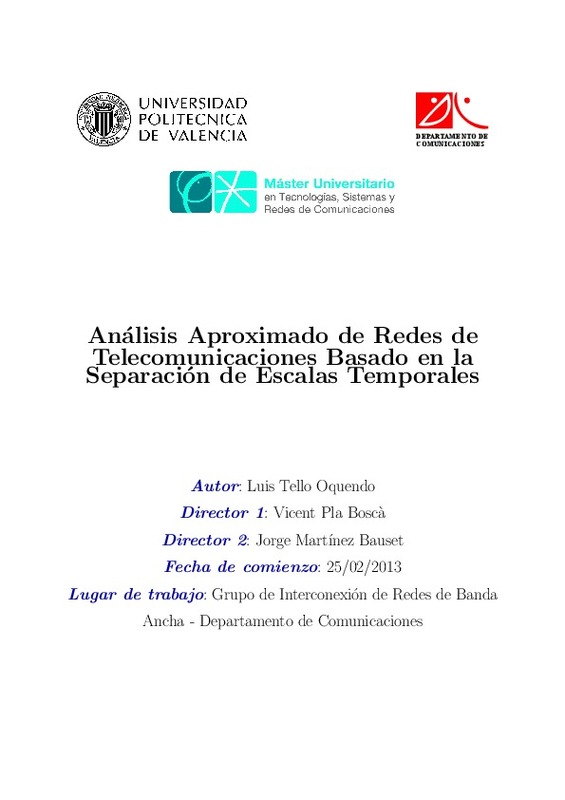JavaScript is disabled for your browser. Some features of this site may not work without it.
Buscar en RiuNet
Listar
Mi cuenta
Estadísticas
Ayuda RiuNet
Admin. UPV
ANÁLISIS APROXIMADO DE REDES DE TELECOMUNICACIONES BASADO EN LA SEPARACIÓN DE ESCALAS TEMPORALES
Mostrar el registro sencillo del ítem
Ficheros en el ítem
| dc.contributor.advisor | Pla Boscà, Vicent
|
es_ES |
| dc.contributor.advisor | Martínez Bauset, Jorge
|
es_ES |
| dc.contributor.author | Tello Oquendo, Luis Patricio
|
es_ES |
| dc.date.accessioned | 2013-10-24T12:38:59Z | |
| dc.date.available | 2013-10-24T12:38:59Z | |
| dc.date.created | 2013-09-17 | |
| dc.date.issued | 2013-10-24 | |
| dc.identifier.uri | http://hdl.handle.net/10251/33060 | |
| dc.description.abstract | Cadenas y procesos de Markov son herramientas de modelado ampliamente utilizadas para evaluar el desempeño de redes de comunicaciones. El tamaño del sistema y la existencia de diferentes tipos de usuarios a menudo hacen que el análisis de la cadena o proceso de Markov sea computacionalmente intratable. Cuando los eventos de cada tipo de usuario se producen a escalas de tiempo suficientemente separadas, la denominada aproximación cuasi-estacionaria (QSA) ha demostrado ser precisa y altamente eficiente. Recientemente, se ha introducido una generalización de la aproximación cuasi-estacionaria (GQSA). La nueva aproximación tiene como objetivo mejorar la precisión al precio de mayor coste computacional. En este trabajo se realiza un estudio comparativo de la precisión y el coste computacional de ambos métodos de aproximación QSA y GQSA. En particular, se explora la evolución de la precisión a medida que la separación entre las escalas temporales varía, y el compromiso entre precisión y coste computacional. Los resultados indican que mientras la nueva GQSA mejora la precisión en algunos casos, no se produce en todos ellos, y más importante aún, es difícil predecir en qué casos la precisión se puede mejorar mediante la utilización del nuevo método. | es_ES |
| dc.description.abstract | Markov chains are a widely used modeling tool for communication networks. The system size and the existence of different user types often make the analysis of the Markov chain computationally intractable. When the events of each user type occur at sufficiently separated time scales, the so-called quasi-stationary approximation (QSA) has proven to be accurate and highly efficient. Recently, a generalization of the quasi-stationary approximation (GQSA) has been introduced. The new approximation aims to improve the accuracy at the price of higher computational cost. In this paper, we carry out a comparative study of the accuracy and computational cost of both approximation methods QSA and GQSA. In particular, we explore the evolution of accuracy as the separation between time scales varies, and the trade-off between accuracy and computational cost. Our results indicate that while the new GQSA improves the accuracy in some instances, it does not occur in all of them; and more importantly, it is difficult to predict in which cases accuracy can be enhanced by the new method. | es_ES |
| dc.format.extent | 31 | es_ES |
| dc.language | Español | es_ES |
| dc.publisher | Universitat Politècnica de València | es_ES |
| dc.rights | Reconocimiento - No comercial - Sin obra derivada (by-nc-nd) | es_ES |
| dc.subject | Sistemas Cognitive Radio | es_ES |
| dc.subject | Sistemas de Servicios integrados | es_ES |
| dc.subject | Descomposición de escalas temporales | es_ES |
| dc.subject | Cognitive Radio Systems | es_ES |
| dc.subject | Integrated Services Systems | es_ES |
| dc.subject | Time-scale decomposition | es_ES |
| dc.subject.other | Máster Universitario en Tecnologías, Sistemas y Redes de Comunicaciones-Màster Universitari en Tecnologies, Sistemes i Xarxes de Comunicacions | es_ES |
| dc.title | ANÁLISIS APROXIMADO DE REDES DE TELECOMUNICACIONES BASADO EN LA SEPARACIÓN DE ESCALAS TEMPORALES | es_ES |
| dc.type | Tesis de máster | es_ES |
| dc.rights.accessRights | Abierto | es_ES |
| dc.contributor.affiliation | Universitat Politècnica de València. Escuela Técnica Superior de Ingenieros de Telecomunicación - Escola Tècnica Superior d'Enginyers de Telecomunicació | es_ES |
| dc.description.bibliographicCitation | Tello Oquendo, LP. (2013). ANÁLISIS APROXIMADO DE REDES DE TELECOMUNICACIONES BASADO EN LA SEPARACIÓN DE ESCALAS TEMPORALES. http://hdl.handle.net/10251/33060. | es_ES |
| dc.description.accrualMethod | Archivo delegado | es_ES |
Este ítem aparece en la(s) siguiente(s) colección(ones)
-
ETSIT - Trabajos académicos [2408]
Escuela Técnica Superior de Ingenieros de Telecomunicación






